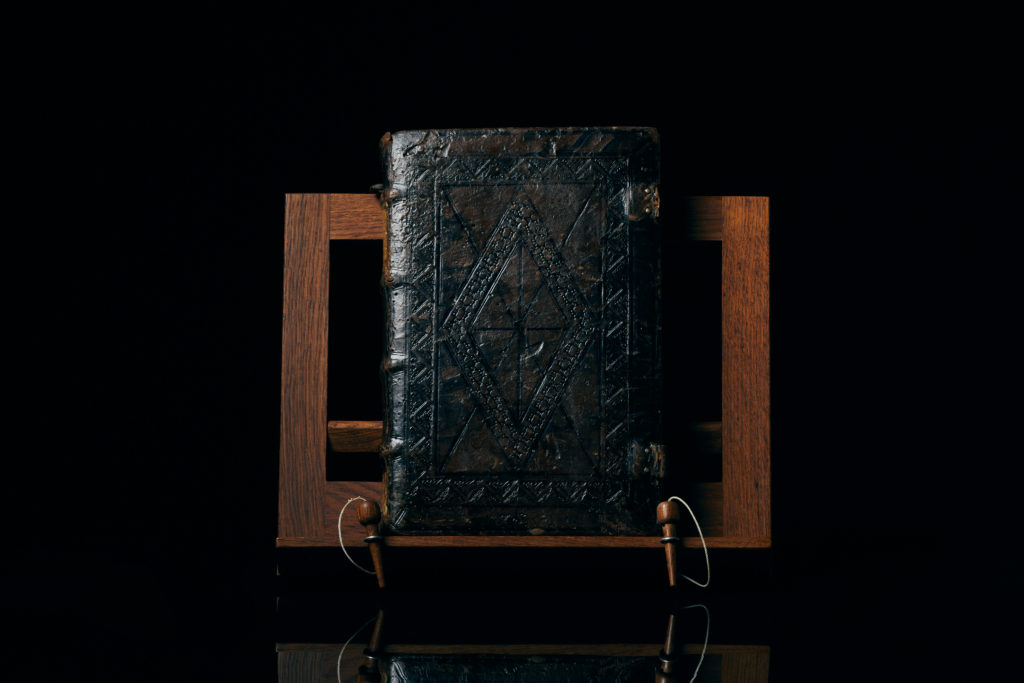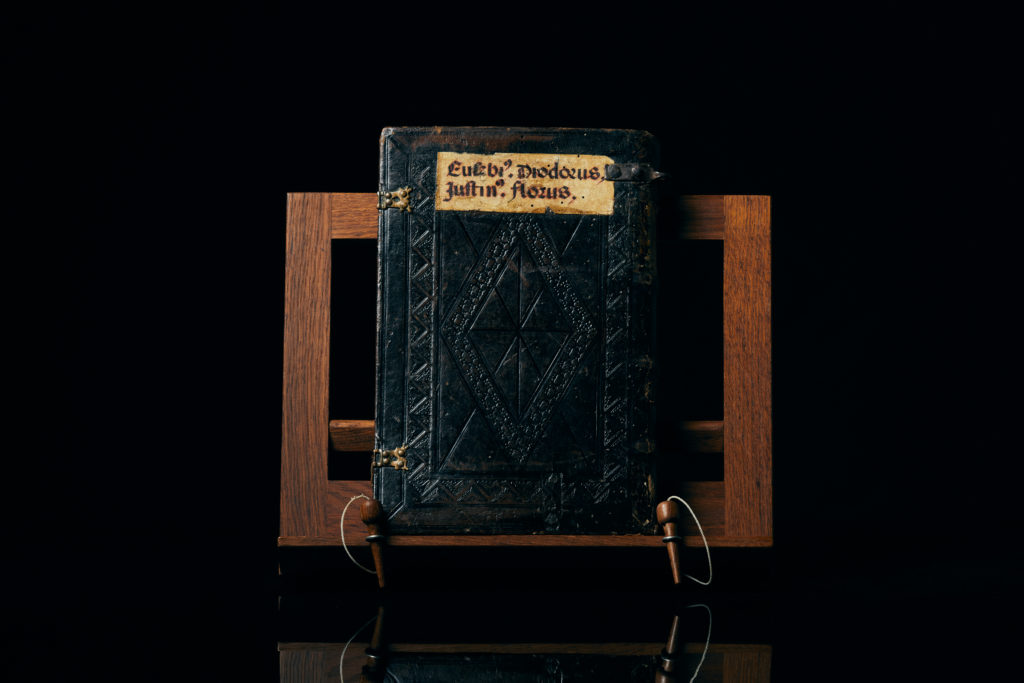一冊の本を例として、書物史講座として四回に分けて、お話しさせていただきます。
「本の外観」第一回
本は読むものと決めてかかっている読者もいるでしょうが、古書の場合はその外観を分析し楽しむこともできます。 例えば、ここでご紹介するフォリオ判(全紙を一度畳んだ丁を合わせて作る)のインキュナビュラ(1501年以前に出版された印刷本)は、表表紙にはない書物の内容(4名の歴史家の名前)が裏表紙に書かれています。背表紙にも書かれた同じ内容は、16世紀に他の人物によって書かれたようです。これらの状況から、本書は机の上に、裏表紙を上にして置かれていたと考えられます。盗まれないように鎖で繋がっていた形跡がありますが、これについて次回に解説しましょう。
You would think that the book is meant to be for reading, but you can also enjoy analysing the external appearance. For example, this incunabula, a printed book before 1501, is a folio (made of quires folded once), bearing the names of four historians on the lower cover rather than the upper cover. The same set of names was also written on the spine, but presumably in the sixteenth century. Judging from these observations, the book was supposedly placed on the flat table with the lower cover visible to us. There remains a chain hole attached to the binding, which will be discussed in the next run.
Sammelband: “a German word meaning ‘anthology’ or ‘omnibus’, often used to describe a bound volume containinga number of separately published pamphlets on a connected theme” (The Oxford Companion to the Book, OUP, vol.2, pp.1121-1122), supposedly a collection of no less than three connected treatises in the same format, printed at or or a nearby city, and bound in one volume.
1. Eusebius [Caesariensis]. De evangelica praeparatione. Venice: Bernardinus Benalius, 31 May 1497. Folio. [108] leaves. [BMC V, p. 376. Goff E-122. GW9444. Hain-Copinger *6706](Bound together with)
2. Diodorus Siculus. Bibliothecae historiae libri VI. [Venice: Impressum per Philippum Pincium, 20 November 1493]. Folio. 52 leaves (i-li, [l, blank]). Complete with final blank. Published with Lucianus’s Vera historia (the first eight leaf gathering), but this part was apparently never bound into this copy. [BMC V, p. 495. Goff L-328. Hain-Copinger 10260 (all under Lucianus)](And)
3. Justinus, [Marcus Junianus]. Epitomae in Trogi Pempeii historias.[Together with]
4. Lucius Florus. Epitome. [Venice: Joannes Rubeis Vercellensis, after 1489-90]. Folio. 54 leaves ([i], ii-liiii). [BMC V, p. 421. Goff J-619. Hain-Copinger *9653]Purchased at Yushodo
「本の外観」第二回 Chained book 鎖に繋がれた本
本書の外観から分かる特徴の一つはchained book (鎖に繋がれた本)だったことである。書物が盗難に遭わないための工夫と思われる。本書は大学や修道院の図書館にあったものと考えられる。前小口の横には、金属製の留め金(clasp)や受けがね(catch)の形跡があり、ファスナーの役目を果たす革ひもが、今は失われた。前小口に4つの囲みがペンで施され、それぞれに本書の内容(歴史4作品の著者名)が書かれていたようだ。
A metal hole suggests that this was a chained book to avoid the book theft in the library. There remain clasps and catches, while the leather thongs are gone. The four blocks, added by a pen on the fore-edge, indicate that the names of the four historians were added.
「本の外観」第三回 Sammelband 合綴本
Sammelbandはドイツや英米で用いられる用語だが、未だ熟していない。ここでは、出版年、出版地が同一か近いもので、3点以上の内容が近い主題をもつ本を合冊したものを言う。本書は、4点の歴史書で、いずれもヴェニスで1490年代に出版されており、Sammelbandと言える。
‘Sammelband’ is used in Germany as a bound volume of more than three printed and/or manuscripts which were made in the same or neighboring city in the same period. The present volume comprises four history book by Eusebius (1490), Diodorus (1493), Justinus (1489-1490), and Florus (1489-1490), all printed in Venice.
「本の外観」第四回 印刷、書き込みから製本へ
この回では、本書について次のような特徴について触れている 印刷された傍注 余白書き込み イタリック体に習熟した人文主義者による手書き ペンとインクによる下線 手引き印刷機(グーテンベルグ以来、19世紀の輪転機の発明まで用いられた) 手引き印刷では、印刷インクのノリをよくするため、印刷前に手漉き紙を予め湿らせた。印刷後は乾燥させる 乾いた表面に起きる起伏は、万力で平らにした 「注目せよ」(N.B.)のマークは中世以来用いられた 余白の書き込みを精査することによって、これらの独立した論文が合綴される前に注釈が施されたかどうか知ることができるかもしれない
In this video, the following characteristics are referred to: Printed side-notes Marginalia added by humanists in accomplished italic handwriting Underlining with pen and ink Hand-pull printing press Wetting water handmade paper before printing, and drying Rough surface getting flattened by hand press ‘Nota bene’ (N.B.) marks The presence of marginalia may suggest whether or not these tracts were read, annotated, and then bound
書物史講座 再生リスト






コメント